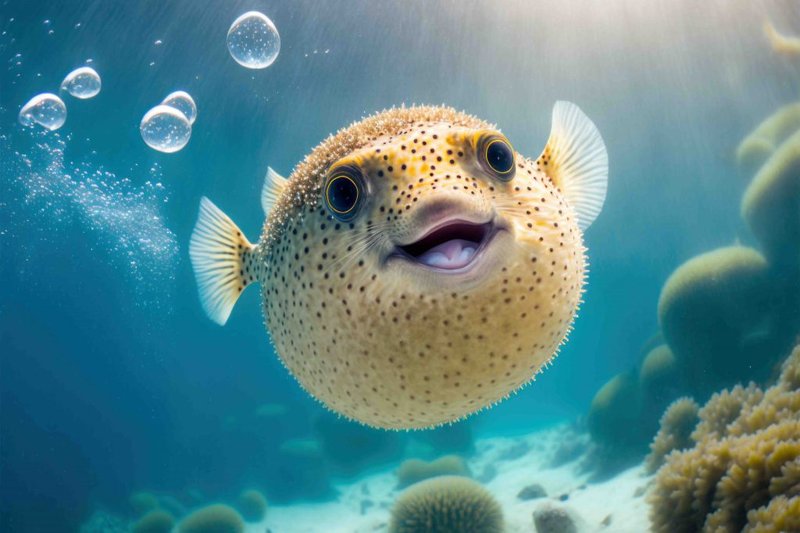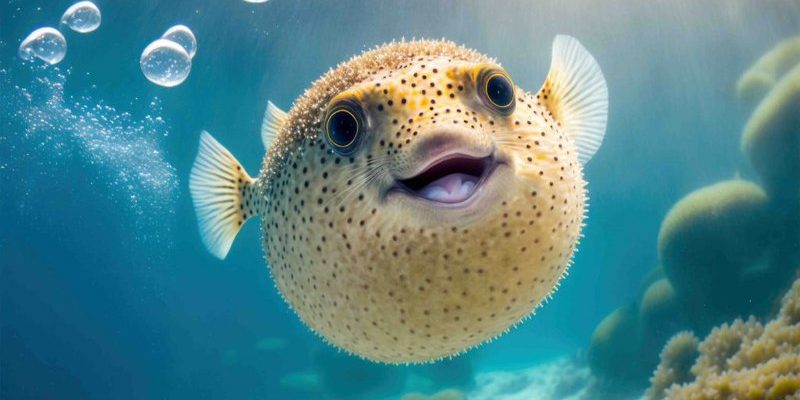
You might be surprised to learn that pufferfish are not just adorable; they’re also packed with interesting facts and a few surprises that might make you rethink how you see them. From their fascinating defense mechanisms to the secret of their toxic nature, there’s much more beneath the surface than just their playful exterior. So, grab a cup of coffee, and let’s explore ten captivating facts about these incredible fish!
1. Pufferfish Can Puff Up!
One of the most famous traits of the pufferfish is their ability to inflate. When they feel threatened, these fish can gulp in water or air to swell up to several times their normal size. This clever tactic makes them look larger and more intimidating to potential predators. Imagine blowing up a balloon; that’s similar to what these fish do!
But there’s more to it than just appearing bigger. Their spiny skin also becomes more pronounced during this process, making them even less appetizing to any would-be attackers. Honestly, who would want to eat a spiky, balloon-like fish? This self-defense mechanism is a brilliant survival tactic seen in many types of pufferfish.
2. Not All Pufferfish Are Toxic
You might think that all pufferfish carry the same lethal punch, but that’s not the case. While many species are poisonous, not every pufferfish has the same level of toxicity. The toxin that makes some pufferfish harmful to eat is called tetrodotoxin. This substance is found in various parts of the fish, particularly in their liver and skin.
Tetrodotoxin is incredibly potent—up to 1,200 times more toxic than cyanide! But here’s the thing: some species, like the Giant Pufferfish, don’t produce this toxin at all. Instead, they rely on their ability to puff up or their tough skin for protection. This variation is a reminder that nature loves diversity, and not all creatures follow the same rules.
3. Their Diet Is Quite Interesting
Pufferfish have a unique eating style that sets them apart from many other fish. They primarily feed on hard-shelled animals like clams, snails, and crustaceans. Their beak-like teeth are perfectly designed for cracking open these tough exteriors. Imagine a bird using its beak to pop open a nut—that’s how a pufferfish goes about its meals!
Interestingly, the way they eat contributes to their growth. As they munch on hard shells, their teeth continue to grow throughout their lives, making it essential for them to maintain a diet that challenges those pearly whites. This eternal dental upkeep is quite a fascinating aspect of their existence!
4. They Have a Unique Swimming Style
When you watch a pufferfish swim, you might notice that they don’t use their tails quite like most fish. Instead, they primarily rely on their pectoral fins for movement. This gives their swimming a slow, almost graceful quality, resembling a little underwater balloon gliding through the water.
This unique swimming style allows them to be less engaging for predators, as they aren’t as quick or energetic as other fish. They can float and hover, making them a delightful sight to observe. Plus, it adds to their charm—who wouldn’t love watching a pufferfish meander through the ocean, puffed up and calm?
5. Pufferfish Can Regenerate
Here’s something truly remarkable: pufferfish have the ability to regenerate certain parts of their bodies. If they lose a fin or suffer minor injuries, they can eventually regrow those lost appendages. It’s like having a built-in repair system!
This regeneration ability is more common among many fish species than you might realize, but the pufferfish takes it to the next level. During stressful or damaged conditions, their body adapts and starts the healing process. It’s nature’s way of ensuring that these quirky fish can continue to thrive in their watery homes.
6. Some Pufferfish Are Used in Cuisine
In some cultures, particularly in Japan, pufferfish are considered a delicacy known as fugu. However, preparing fugu is no small feat. Only licensed chefs are allowed to serve this dish, as they must know how to expertly remove toxic parts to ensure safety.
The thrill of dining on fugu lies not just in its delicious flavor but also in the risk involved. It’s like a culinary game of chance! Some adventurous diners seek out this dish for the experience, while others prefer to admire pufferfish from a distance—totally understandable when you consider the potential consequences.
7. They Exhibit Social Behavior
You might picture pufferfish as solitary creatures, but the truth is, they can be social! In some species, pufferfish are known to interact with one another, forming small groups. They engage in playful behavior, like nibbling on plants or doing synchronized swimming moves.
This social aspect adds to their charm and showcases their intelligence. Just like us, they enjoy the company of others from time to time! Watching pufferfish interact can be as captivating as their ability to puff up—who knew these little guys had such personalities?
8. Their Colors and Patterns Are Stunning
Pufferfish come in an incredible array of colors and patterns. Some are a vibrant yellow, while others boast striking patterns of blue and black. These colors not only make them visually appealing but also serve as a form of camouflage in their natural habitats.
By blending into their surroundings, they can avoid detection by predators. It’s like wearing the perfect outfit for a stealth mission! Their coloration varies based on species and environment, making each pufferfish unique. If you ever get the chance to see them up close, you’ll be treated to a dazzling display of nature’s artistry.
9. They Have a Short Lifespan
Despite their remarkable abilities, pufferfish generally have a relatively short lifespan compared to other fish. Many species only live for about 5 to 10 years in the wild. Their life is often filled with beautiful moments of swimming and puffing, but environmental factors can take a toll.
Pollution, habitat destruction, and overfishing are significant threats that can impact their lifespan. It’s a gentle reminder that even the most enchanting creatures need a healthy environment to thrive. Conservation efforts are essential to ensure these fascinating fish can continue to flit through our oceans for years to come.
10. They’re Iconic in Pop Culture
Pufferfish have made their mark in pop culture, appearing in movies, cartoons, and even video games. Their quirky looks and amusing behaviors have inspired characters that bring a smile to many faces. Think of characters in animated series that puff up in funny ways; they resonate with audiences young and old.
The iconic status of these fish highlights our fascination with the unusual and unexpected in nature. They remind us that even in the underwater world, there’s no shortage of wonder and whimsy. From educational documentaries to playful cartoons, pufferfish continue to charm and entertain, keeping the spirit of curiosity alive.
Wrap It Up
Pufferfish are more than just cute little fish; they embody a fascinating blend of nature’s creativity and resilience. From their impressive puffing abilities to their stunning colors and social behaviors, there’s so much to admire and learn. It’s crucial to appreciate their role in our ecosystems and the delicate balance that allows them to thrive.
So, whether you’re a marine enthusiast or just someone who loves learning about the wonders of nature, pufferfish offer endless fascination. Next time you see one, take a moment to appreciate all the unique qualities that make them truly special!

